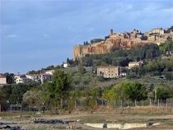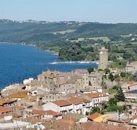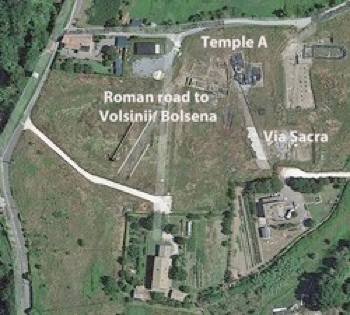

Orvieto, with Campo della Fiera in foreground Bolsena
Cassius Dio (as summarised by John Zonaras) described the tragic aftermath of the triumph of Marcus Fulvius Flaccus at Etruscan Volsinii in 264 BC (discussed on the previous page):
-
“The consul scourged to death the [rebel slaves who held Velzna] ... and he razed the city to the ground; the native-born citizens, however, and any servants who had been loyal to their masters, were settled by him on another site” (‘Roman History’, 10 - search on “Volsinii”).
While the location of Velzna has been a matter of debate (albeit that most scholars now accept that it was on the impregnable site of Orvieto), there has never been any doubt that ‘new’ Volsinii was on the much less defensible site of modern Bolsena. Indeed, the name “Bolsena” is clearly derived from ‘Volsinii’.
Very little is known about the early history of the new settlement, which presumably functioned under a treaty that tied it to Rome. According to Pierre Gros (2013, referenced below, at p. 93), its original forum probably occupied the elevated site at località Mercatello that was subsequently terraced for the amphitheatre ( see the page on Volsinài in the Imperial period).
The settlement seems to have remained unwalled for almost a century, probably because the Romans wanted to make sure that its inhabitants could never again defy them. However, an impressive circuit of walls some 4.5 km long was finally built ca. 180 BC, enclosing an area much larger that that used for habitation. The commercial and strategic importance of Volsinii must have increased in this period after the building of:
-
✴Via Clodia, in ca. 196 BC ; and
-
✴Via Cassia, in ca. 154 BC.
Pierre Gros (2013, referenced below, at p. 90) suggested that these developments were probably linked to the formation of a colony (albeit that any such colonisation is otherwise undocumented).
A now-lost inscription (AE 1916, 0115) which was found at contrada Civitale, Bolsena in 1915, reads:
L(ucius) Caecina L(uci) (!) / q(uaestor) tr(ibunus) p(lebis) p(raetor) pr(o)co(n)s(ul)
IIIIvir i(ure) d(icundo) / sua pecu/nia vias / stravit
This inscription probably dates to the triumviral period and is thus discussed more fully on the following page. For now, we need only note that Lucius Caecina held the post of quattuorvir iure dicundo, which indicates that Volsinii became a municipium, almost certainly after the Social War (90 BC). As William Harris (referenced below, at p. 248 and p. 335) pointed out, a number of known inscriptions reveal that Volsinii (together with one other Etruscan city, Arretium) was assigned to the Pomptina tribe.
Cult of Nortia
As noted on the previous pages, the cult of the Etruscan goddess Nortia was associated with Volsinii long after most other Etruscan cults had been long-forgotten or subsumed by those of Rome. This section looks at the possible cult sites of the goddess in the Republican period.
Temple A at Campo della Fiera

Excavated site at Campo della Fiera
The sanctuary at Campo della Fiera (discussed - link)outside Velzna had probably functioned as the sanctuary of the Etruscan Federation until 264 BC. It would surely have suffered damage in the mayhem of 264 BC, when Velzna was destroyed and when Voltumna, the presiding deity at the sanctuary, was called to Rome. However, as I discussed in this page, one of its temples (labelled by the excavators as Temple A) remained in use thereafter. I suggested that, after the destruction of Velzna, Temple A and its sacred area were dedicated to Nortia and served as an extra-urban sanctuary of the ‘new’ Volsinii.
I further suggested that the road that linked Temple A to Volsinii/ Bolsena (part of which is picked out by white parallel lines in the aerial view above) constituted an ‘umbilical cord’ some 10 km long, linking the displaced people there to what remained of their ancient city and ancient religion. If this is correct, then Temple A, now dedicated to Nortia, would have symbolised this lost heritage, and this probably explains why (as demonstrated in my page on Volsinii in the Imperial Period), the Volsinians venerated Nortia in her Etruscan form long after other Etruscan deities had been absorbed into Roman equivalents or simply forgotten.
Capitolium ?
According to Pierre Gros (2013, referenced below, at p. 93), citing Maria Luisa Rinaldi (referenced below), aerial photographs suggest that the existence of a tripartite temple, perhaps a capitolium (a temple dedicated to the Capitoline triad: Tinia/Jupiter; Uni/Juno; and Nortia/Minerva) in località Mercatello (the site of the original forum and subsequently the site of the amphitheatre). This could have been a replacement for the Tempio del Belvedere at Velzna, which had been destroyed along with the city itself (as discussed in the previous page).
Read more:
P. Gros, “La Nuova Volsinii: Cenno Storico sulla Città”, in:
G. della Fina and E. Pellegrini (Eds), “Da Orvieto a Bolsena: un Percorso tra Etruschi e Romani”, (2013 ) Pisa, (pp. 88-105)
W. Harris, “Rome in Etruria and Umbria”, (1971) Oxford
M. L. Rinaldi, “Città Romane del III Secolo a. C. in Ambiente Etrusco: l' Esempio di Volsinii Novi”, Studi Romagnoli, 13 (1962) 143-58
Ancient History: Velzna/ Volsinii Destruction of Velzna
Volsinii (Bolsena): Republican Period; TriumviralPeriod;
Early Empire; Imperial Period; Late Empire;
Rescript of Constantine at Hispellum (ca. 335 AD)
Return to the page on History of Orvieto.



